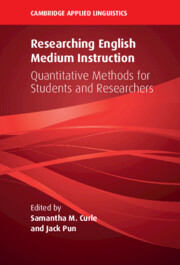Book contents
- Researching English Medium Instruction
- The Cambridge Applied Linguistics Series
- Researching English Medium Instruction
- Copyright page
- Dedication
- Contents
- Figures
- Tables
- Preface
- Acknowledgments
- Notes on Editors
- Notes on Contributors
- An Introduction to Researching English Medium Instruction Using Quantitative Research Methods
- Part I Theoretical Chapters
- Part II Empirical Chapters (Case Studies)
- 5 The Application of Partial Least Squares Structural Equation Modeling in Studies of EMI
- 6 Factor Analysis in Writing Research
- 7 Analyzing Questionnaire Data through Many-Facet Rasch Measurement: A Pilot Study of Students’ Attitudes toward EMI in the Chinese Higher Education Context
- 8 Questionnaire Development and Analysis in EMI Research
- 9 Effects of EMI on Learners’ Linguistic Development
- 10 Path Analysis of Science Learning in Hong Kong’s EMI Secondary Schools
- 11 Questionnaire Survey in Researching EMI
- 12 The Use of MANOVA in Analyzing the Effects of Gender on Perceived Difficulties in Speaking and Writing in a Hong Kong EMI University
- 13 Using a Longitudinal Quantitative Design to Investigate Student Transition from Secondary School to EMI Higher Education
- 14 A Corpus-Based Multidimensional Analysis of EMI University Classroom Discourse
- Index
- References
12 - The Use of MANOVA in Analyzing the Effects of Gender on Perceived Difficulties in Speaking and Writing in a Hong Kong EMI University
from Part II - Empirical Chapters (Case Studies)
Published online by Cambridge University Press: 14 December 2024
- Researching English Medium Instruction
- The Cambridge Applied Linguistics Series
- Researching English Medium Instruction
- Copyright page
- Dedication
- Contents
- Figures
- Tables
- Preface
- Acknowledgments
- Notes on Editors
- Notes on Contributors
- An Introduction to Researching English Medium Instruction Using Quantitative Research Methods
- Part I Theoretical Chapters
- Part II Empirical Chapters (Case Studies)
- 5 The Application of Partial Least Squares Structural Equation Modeling in Studies of EMI
- 6 Factor Analysis in Writing Research
- 7 Analyzing Questionnaire Data through Many-Facet Rasch Measurement: A Pilot Study of Students’ Attitudes toward EMI in the Chinese Higher Education Context
- 8 Questionnaire Development and Analysis in EMI Research
- 9 Effects of EMI on Learners’ Linguistic Development
- 10 Path Analysis of Science Learning in Hong Kong’s EMI Secondary Schools
- 11 Questionnaire Survey in Researching EMI
- 12 The Use of MANOVA in Analyzing the Effects of Gender on Perceived Difficulties in Speaking and Writing in a Hong Kong EMI University
- 13 Using a Longitudinal Quantitative Design to Investigate Student Transition from Secondary School to EMI Higher Education
- 14 A Corpus-Based Multidimensional Analysis of EMI University Classroom Discourse
- Index
- References
Summary
This chapter explores the use of one-way between-groups multivariate analysis of variance (MANOVA) to investigate the effects of gender on perceived English language ability challenges in an English Medium Instruction (EMI) university in Hong Kong. Contrasting with ANOVA which evaluates mean differences on one dependent variable, MANOVA evaluates if there are mean differences on two or more dependent variables. The two dependent variables used were perceived writing challenges and perceived speaking challenges. The independent variable was gender. We checked for univariate and multivariate outliers, homogeneity of variance-covariance matrices and normality and found no deviation from the standard parameters. The results show a significant difference between males and females in terms of the combined dependent variables, F (2, 75) = 3.444, p = 0.037, Wilks’ Lambda = 0.913 and partial eta squared = 0.087. When the dependent variable is analysed separately with reference to the Bonferroni adjusted alpha level of 0.025, a significant difference is only found between males and females in terms of the perceived speaking challenges, F (1, 75) = 6.658, p = 0.012, partial eta squared = 0.084. A closer examination of the mean score shows that females (M = 3.042, SD = 0.34) perceived speaking English to be more of a challenge than males did (M = 2.71, SD = 0.55). The findings are discussed in relation to teaching and learning in an EMI university.
Keywords
- Type
- Chapter
- Information
- Researching English Medium InstructionQuantitative Methods for Students and Researchers, pp. 207 - 226Publisher: Cambridge University PressPrint publication year: 2024

